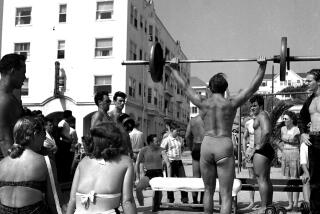Exercise a Fit Resolution for New Year : Walking: New guidelines suggest that the greatest benefit is gained by those who have done nothing and start doing something.
- Share via
WASHINGTON — This year’s New Year’s resolution to exercise may be the easiest to keep.
You no longer need to jog, dance or lift weights. You needn’t do anything more taxing than walk for a half hour a day--and you can break the half hour into chunks as small as you want.
The new guidelines from the federal Centers for Disease Control and Prevention and the American College of Sports Medicine were issued last summer. Researchers have found that the greatest exercise benefit goes to those who have done nothing and start doing something. Exercise cuts their risk of death from many causes.
“It can reduce their risk for disease (as) much as smoking cessation,” said researcher Steven N. Blair, an epidemiologist at the Cooper Institute for Aerobics Research in Dallas.
If you haven’t tried the guidelines yet, their supporters can’t think of a better time than now.
“We know New Year’s resolutions are important,” said Russell R. Pate, ACSM’s president. The trick is to make the resolutions last.
“What we’ve done is pretty much eliminated the excuses--that they don’t have the time, money, equipment or a place to exercise--that most people give for not exercising,” said Dr. Kenneth Cooper, the aerobics godfather who founded the institute where Blair works.
The guidelines are aimed at making exercise a part of life. Gardening counts. So does taking the stairs instead of the escalator, or parking your car at the far edge of the mall instead of as close as you can get.
The idea is to pick “a small number of specific changes (people) will be prepared to make on a very consistent basis,” Pate said. Vague goals, such as resolving to do some unstated form of exercise, eventually are ignored, he said.
This doesn’t mean everyone will resolve to exercise, and 1994 will see streets full of walkers.
About 60% of Americans don’t exercise, and some of them just don’t want to, because they don’t think it’s fun--they might rather watch television, said researcher Rod K. Dishman of the University of Georgia.
“Americans are creative at avoiding work,” Dishman said. “We are ingenious in our ways to conserve human energy. Some people call that laziness.”
Laziness misses an opportunity, Cooper believes. He’d have people see the issue this way: “If I’m not motivated, can I afford not to be, since the benefits are so substantial with so little investment?”
Others fail from an inability to plan, Dishman said, “It’s a misperception (that) it’s always a motivational problem,” he said. “It takes a hell of a lot of motivation to overcome bad planning.”
If you’re willing to start 1994 with a new burst of exercise, Dishman advises you to think of activities you’ve tried or would like to, and see exactly when and where in your day they might be done, he said. The exercise that fits your desires and schedule best is the one to start with, he said.
Pate, Cooper and Dishman agree that the goals amount to a solid minimum, and are not meant to discourage people from doing more. Cooper emphasizes that there is a difference between being healthy (having a low risk of disease) and being fit--which takes more work but which gives you greater endurance, vitality and quality of life.
But aerobic fitness means jogging and similar activities, done at least three times a week for at least 20 minutes at a time.






